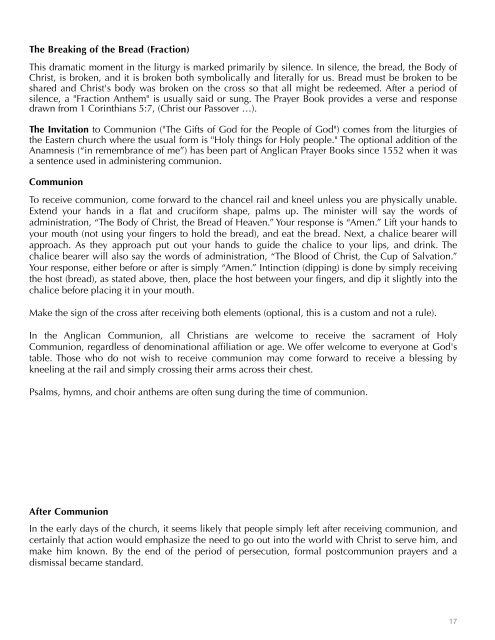Instructed Eucharist June 30, 2019, 3 Pentecost PDF
Create successful ePaper yourself
Turn your PDF publications into a flip-book with our unique Google optimized e-Paper software.
The Breaking of the Bread (Fraction)<br />
This dramatic moment in the liturgy is marked primarily by silence. In silence, the bread, the Body of<br />
Christ, is broken, and it is broken both symbolically and literally for us. Bread must be broken to be<br />
shared and Christ's body was broken on the cross so that all might be redeemed. After a period of<br />
silence, a "Fraction Anthem" is usually said or sung. The Prayer Book provides a verse and response<br />
drawn from 1 Corinthians 5:7, (Christ our Passover …).<br />
The Invitation to Communion ("The Gifts of God for the People of God") comes from the liturgies of<br />
the Eastern church where the usual form is "Holy things for Holy people." The optional addition of the<br />
Anamnesis (“in remembrance of me”) has been part of Anglican Prayer Books since 1552 when it was<br />
a sentence used in administering communion.<br />
Communion<br />
To receive communion, come forward to the chancel rail and kneel unless you are physically unable.<br />
Extend your hands in a flat and cruciform shape, palms up. The minister will say the words of<br />
administration, “The Body of Christ, the Bread of Heaven.” Your response is “Amen.” Lift your hands to<br />
your mouth (not using your fingers to hold the bread), and eat the bread. Next, a chalice bearer will<br />
approach. As they approach put out your hands to guide the chalice to your lips, and drink. The<br />
chalice bearer will also say the words of administration, “The Blood of Christ, the Cup of Salvation.”<br />
Your response, either before or after is simply “Amen.” Intinction (dipping) is done by simply receiving<br />
the host (bread), as stated above, then, place the host between your fingers, and dip it slightly into the<br />
chalice before placing it in your mouth.<br />
Make the sign of the cross after receiving both elements (optional, this is a custom and not a rule).<br />
In the Anglican Communion, all Christians are welcome to receive the sacrament of Holy<br />
Communion, regardless of denominational affiliation or age. We offer welcome to everyone at God's<br />
table. Those who do not wish to receive communion may come forward to receive a blessing by<br />
kneeling at the rail and simply crossing their arms across their chest.<br />
Psalms, hymns, and choir anthems are often sung during the time of communion.<br />
After Communion<br />
In the early days of the church, it seems likely that people simply left after receiving communion, and<br />
certainly that action would emphasize the need to go out into the world with Christ to serve him, and<br />
make him known. By the end of the period of persecution, formal postcommunion prayers and a<br />
dismissal became standard.<br />
17



